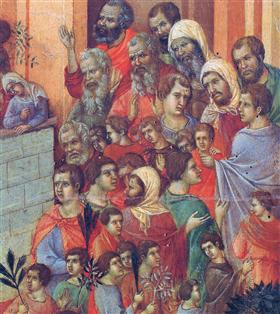 |
| The Entry into Jerusalem -- Duccio |
LITURGY OF THE PASSION
Though still commonly called Palm Sunday, in modern liturgical practice the Sunday before Easter Day is referred to as ‘The Sunday of the Passion’. This is because it is the first liturgical observance in the season of Holy Week and Easter when a Gospel narrative of the sufferings (passion) of Jesus is read. The older title is not lost, however. This Sunday is unique in the Lectionary because it prescribes two Gospels, and the first of these -- for the Liturgy of the Palms – tells the story of Christ’s arrival in Jerusalem for the Passover. Riding on a donkey, and greeted with enthusiasm by a crowd waving palm branches, it is traditionally described as his ‘triumphal entry’.
Though still commonly called Palm Sunday, in modern liturgical practice the Sunday before Easter Day is referred to as ‘The Sunday of the Passion’. This is because it is the first liturgical observance in the season of Holy Week and Easter when a Gospel narrative of the sufferings (passion) of Jesus is read. The older title is not lost, however. This Sunday is unique in the Lectionary because it prescribes two Gospels, and the first of these -- for the Liturgy of the Palms – tells the story of Christ’s arrival in Jerusalem for the Passover. Riding on a donkey, and greeted with enthusiasm by a crowd waving palm branches, it is traditionally described as his ‘triumphal entry’.
It is only after modern worshipers have enacted this scene by taking part in their own procession, that they listen to the first Passion narrative of Holy Week –
usually read or sung in a dramatic form by a number of different voices. Though
this second Gospel, whether in the full or the abbreviated form, is much
longer, the first is no less crucial in establishing the shape of our journey to
Easter. On Palm Sunday we begin with triumph, but the triumph is short lived – and
hollow. The Bible readings for days that follow reflect the rising
tension, and contention, that surrounds Jesus. It culminates in the events of Maundy Thursday and Good Friday -- his
betrayal, trial and death.
 |
| Crucifixion -- Durer |
We need to grasp the depth of the degradation, pain and failure,
to which Jesus is subjected, together with the strength of his unwavering
obedience to God, in order properly to understand both the shallowness of his
‘triumphal’ entry on Palm Sunday, and the significance of his Resurrection on
Easter Day. By this mighty act God shows where true victory is to be found. It
remains, of course, for us to find the grace to long for it.
No comments:
Post a Comment